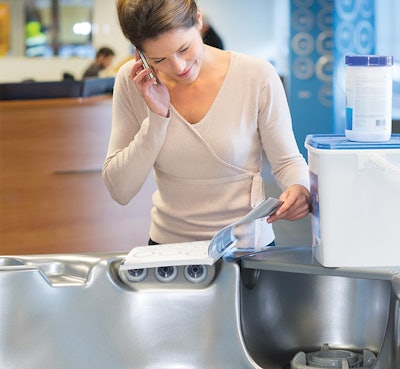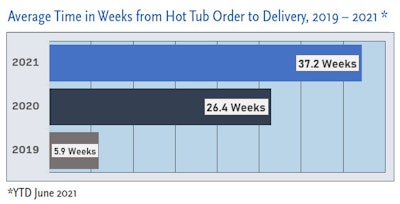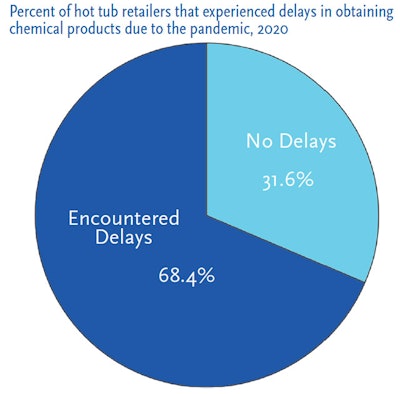
Due to the pandemic, 2020 was a challenging year for the hot tub industry. Nevertheless, hot tub sales were strong in 2020, up in the high single digits for hot tubs sold and delivered from the previous year. Even more significant, some areas saw triple-digit increases in new orders placed.
Many consumers confined to their residences turned their focus and dollars on improving lives at home. As a result, demand for new hot tubs was off the charts in most areas, and dealers sold new units as fast as they could get them. Wait times for new units soared, and hot tub retailers encountered a range of issues from mandatory store closures to shortages in everything from employees to chemicals to portable hot tubs.
PANDEMIC
There were many hot tub manufacturing and shipping delays in 2020 due to extremely high consumer demand, factory shutdowns, materials, parts and labor shortages. With skyrocketing demand across the country, dealers were selling new hot tubs as quickly as they could order and receive the units.
New product availability was extremely poor, especially for the manufacturers shipping from other countries. Interestingly, most domestic manufacturers faced similar issues but fared better, as they either did not shut down entirely or could reopen factories sooner and their point of shipping origin was domestic.
Many hot tub manufacturers closed anywhere from a month to several months during the initial pandemic shut down, depending on where they were located. After they reopened, they faced substantial supply problems; their hot tub inventories sold out quickly, and they struggled the rest of the year to get the necessary materials and parts.
RELATED: SOI Hot Tub Report: Strong Sales
"All the manufacturers and dealers we interviewed experienced massive delays in obtaining inventory in 2020 and will continue to encounter delays in 2021," notes Jerry Kisgen, executive director for Pkdata's Pool & Spa Division. "For example, the lead time from customer order placement for a new hot tub to delivery quadrupled in 2020 and even longer delays are expected through 2021 and into 2022."

CHEMICALS & EQUIPMENT PRODUCTS
It was not just hot tubs that were difficult to source; more than two-thirds of hot tub dealers experienced delays obtaining retail chemical and equipment products. With unexpected high consumer demand for chemicals combined with product production and shipping delays, many dealers had difficulty sourcing adequate pool chemicals and equipment supplies. The chemical products most challenging to obtain were sanitizers. The equipment products most mentioned as delayed were heaters, pumps and filters.


LABOR
During 2020, there was a significant labor shortage that impacted sales and operations for many in the industry. With shutdowns in some areas and employees unable to work, sales were negatively impacted. However, several retailers noted that the manufacturers were more affected by the labor shortages and that impacted their production abilities.
Numerous dealers noted that they had many open positions that they could not fill. As a result, about one-third of hot tub retailers were hampered in their ability to deliver and install hot tubs.
FORECAST
Hopefully, the renewed interest and focus on home improvement will continue as many families realize the value of investing and improving their surroundings for time spent at home. Nevertheless, demand for hot tubs is still extremely high, and this, along with a massive number of orders from 2020 and early 2021 left in the pipeline, should lead to banner sales ahead but also continued difficulties due to product and labor shortages. By all accounts, the shortages in product and material supply chains will continue through 2022 and perhaps into early 2023.
CONCLUSION
The pandemic that began in early 2020 created massive demand for new residential hot tubs. However, while the immediate orders were huge, the industry was not prepared to meet that demand. The volume of hot tubs sold and delivered during 2020 could have been significantly higher if additional industry infrastructure, such as a skilled labor force and necessary equipment products and materials, was in place for the increased business. For those wishing to have more in-depth information on the matter, feel free to check out Pkdata's latest 2020 Hot Tub Report (released in July of this year).
J. Maxwell Kennedy is president, and Jerry Kisgen is executive director, pool and hot tub division of Pkdata, a Duluth, Ga.-based market research and consulting firm that has tracked the swimming pool and hot tub industry since 1992.
This article first appeared in the September 2021 issue of AQUA Magazine — the top resource for retailers, builders and service pros in the pool and spa industry. Subscriptions to the print magazine are free to all industry professionals. Click here to subscribe.











































